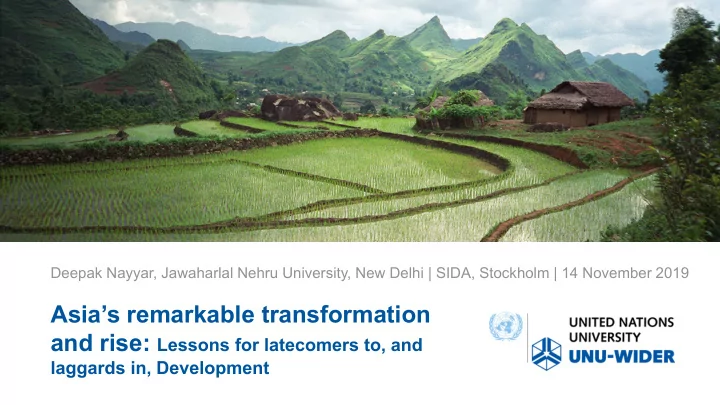

Deepak Nayyar, Jawaharlal Nehru University, New Delhi | SIDA, Stockholm | 14 November 2019 Asia’s remarkable transformation and rise: Lessons for latecomers to, and laggards in, Development
1. Overview • About the book • Contours of change in Asia • Analytical conclusions and policy implications • Findings • Recommendations
2. Contours of change in Asia • • Decline and fall of Asia: 1820-1962 Social development and poverty reduction • Rise of Asia: 1970-2016 • Unequal outcomes in development – Share in world GDP – Between people – GDP per capita: from divergence towards convergence – Among countries – Share of world manufacturing and trade • Enormous diversity, yet discernible patterns
Figure 1 : The Decline and Fall of Asia : 1820-1962 70.0 70.0 120 Percentage of GDP per capita in WE+WO 60.0 60.0 100 Percentage of World population 50.0 50.0 Percentage of World GDP 80 40.0 40.0 60 30.0 30.0 40 20.0 20.0 20 10.0 10.0 0.0 0.0 0 1820 1870 1900 1913 1940 1950 1962 1820 1870 1900 1913 1940 1950 1962 Asia : Population Asia : GDP Asia Western Europe & Western Offshoots
Figure 2: Rising Significance of Asia in the World Economy: 1970-2016 (in percentages) a. World Population and GDP b. GDP per capita 120 70 60 100 50 80 40 60 30 40 20 20 10 0 0 1970 1972 1974 1976 1978 1980 1982 1984 1986 1988 1990 1992 1994 1996 1998 2000 2002 2004 2006 2008 2010 2012 2014 2016 1970 1972 1974 1976 1978 1980 1982 1984 1986 1988 1990 1992 1994 1996 1998 2000 2002 2004 2006 2008 2010 2012 2014 2016 Asia/World GDP per capita Asia/World GDP Asia/World Population Asia/Developing Countries GDP per capita Asia/Industrialised Countries GDP per capita Source: United Nations, National Accounts Statistics and Population Statistics. Note: The percentages have been calculated.
Figure 3: Distribution of World Manufacturing Value Added and Manufactured Exports: 1970-2016 (in percentages) a. World manufacturing value added b. World manufactured exports 100 100 80 80 60 60 40 40 20 20 0 0 1970 1972 1974 1976 1978 1980 1982 1984 1986 1988 1990 1992 1994 1996 1998 2000 2002 2004 2006 2008 2010 2012 2014 2016 1970 1980 1990 2000 2010 2016 Industrialized Countries Developing Countries Asia Asia Developing Countries Industrialized Countries Source: Nayyar (2019)
3. Analytical conclusions and policy implications • Political independence as a turning point • Reshaping of initial conditions • Stunning economic growth – Drivers of growth: supply-side and demand-side – Macroeconomic objectives and policies • Structural transformation: significant but uneven and incomplete
• Economic openness – Necessary but not sufficient – Strategic integration rather than passive insertion – Conducive to industrialization only when combine with industrial policy • Critical role of governments – States and markets: significance of the relationship – Developmental States in East Asia: the special case – Countries without developmental states: the norm – Role of institutionalized checks-and-balances • Wellbeing of people and development of nations
Figure 4: Growth Rates of GDP and GDP per capita in Asia compared with Country-groups in the World Economy 1971-2016: per cent per annum 7 5.8 6 5 4.5 4.10 4 3.3 3.0 2.8 2.72 3 2.5 1.86 2 1.57 1.10 1 0.21 0 GDP GDP per capita World Industrialized Countries Developing Countries Latin America Africa Asia Source: Nayyar (2019). Source: Nayyar (2019).
4. Findings • Rapid economic growth led the development process in Asia and was responsible for its spectacular rise in the world economy • Asia was characterized by significant diversity in paths to, and outcomes in, development, which were shaped by the national context • Governments performed a critical role, ranging from leader to catalyst or supporter, in the economic transformation of Asia • Success at industrialization in Asia was shaped by sensible industrial policy implemented by effective governments
4. Findings (cont.) • Economic openness performed a critical supportive role wherever it was in the form of strategic integration, rather than passive insertion, into the world economy • Inequality between people within countries rose rapidly almost everywhere, while the wide gap between rich and poor countries remained awesome • There was a massive reduction in absolute poverty that could have been even greater but for the rising inequality
5. Recommendations • Coordinate economic policies in pursuit of development objectives, while learning and unlearning from experience, for policies are means not ends • For latecomers to development, heterodox or unorthodox economic policies – in trade, industry and macro-management – are more effective than orthodox policies • Efficient markets and effective governments, together, adapting to each other as time and circumstances change, provide the way forward in development • Economic openness, while necessary, is not sufficient, and is conducive to development only when combined with industrial policy
5. Recommendations (cont.) • Social opportunities for people, through public provision of education and healthcare which improve wellbeing, and economic development of countries reinforce each other in a virtuous circle • Employment matters, for it is the only effective means of eradicating poverty, reducing inequality, and sustaining growth • Economic policies must be conducive to inclusive outcomes for growth to be sustainable and for development to be transformative
www.wider.unu.edu Helsinki, Finland
Recommend
More recommend